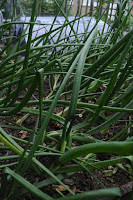 The first week of June has been
at times rather blustery and the plants have been knocked back and forth with
the gusts. I expected the garden to look a little worse for wear, however it
appeared to have remained reasonable intact. I can probably thank the large row
of trees that are in a garden a few doors down from us that appear to filter
out most of the effects of the wind. In short the only damage, if that’s what
you can call it, is that the onions are looking somewhat a little flat and the
clumps of poppies have also been squashed from the centre outwards. But no
worries, the onions will be cropped before too long and the poppies although a
little more squat appear to be none the worse off with plenty of flower buds
pointing skywards.
The first week of June has been
at times rather blustery and the plants have been knocked back and forth with
the gusts. I expected the garden to look a little worse for wear, however it
appeared to have remained reasonable intact. I can probably thank the large row
of trees that are in a garden a few doors down from us that appear to filter
out most of the effects of the wind. In short the only damage, if that’s what
you can call it, is that the onions are looking somewhat a little flat and the
clumps of poppies have also been squashed from the centre outwards. But no
worries, the onions will be cropped before too long and the poppies although a
little more squat appear to be none the worse off with plenty of flower buds
pointing skywards.
It’s not just the windy weather
that has been a problem of late, but the birds too. Some of the sparrows that
have visited the garden in the past have taken a liking to the peas, to such an
extent I now net them. Following on from this I have noticed on more than one
occasion the sparrows sitting on top of the canes, which support my peas and
beans. Initially, I thought nothing of it, until I noticed that they were
taking an unhealthy interest in the twine. They were actually pulling at the
threads so that they could take some as nesting material. I had visions of the
whole coming apart and the offending bird being catapulted across the garden.
To make matters worse, they have been taking the lining from the hanging baskets
as well.
We can’t do anything to control
nature and have to work with it as best we can. By giving plants the Chelsea
chop in May for example, not only do you extend the flowering season, but you
are making the plants shorter and stockier and therefore more resilient to the
gusty weather of late. If your garden is constantly subject to windy weather
then you may find that your plants take action of their own by growing shorter
as a reaction to the conditions in which they grow. To try and filter the wind
it is an idea to use windbreaks such as a hedge or even fencing can be used, so
long as the fence is not solid and is designed with gaps to filter the wind
through.
As for the birds, you cannot help
but like them. They keep the aphid and slug populations down, entertain you
with the antics, especially at the feeders, and as for the fledglings, need I
say more.

